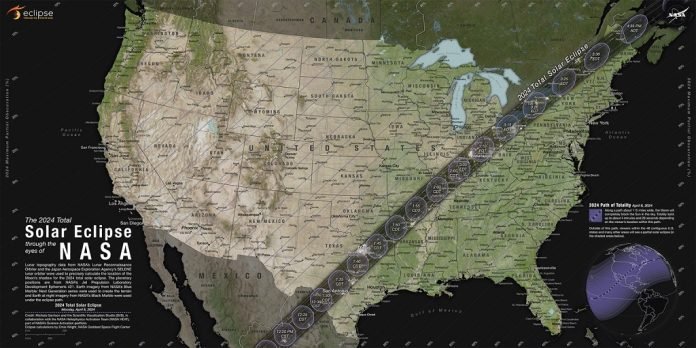
Millions of people are gearing up to view the “Great American Eclipse” on Monday, April 8 – the last total solar eclipse visible from North America for the next 20 years.
The eclipse’s path of totality runs from Texas to Maine.
The fascination with eclipses isn’t new. Eclipses have firm roots in human history across the centuries, with eclipse anecdotes spanning various cultures.
University of Arizona News spoke with Don McCarthy, a longtime professor and astronomer, now retired, at the University of Arizona Steward Observatory, about some of the cultural connections of solar eclipses throughout history.
He discussed eclipses’ cultural significance, explained why being in the path of totality is a “whole-body experience,” and gave advice for anyone interested in chasing more eclipses.
Q: Herodotus, the Greek historian, wrote about a battle fought in the sixth century B.C. in what today is Turkey, when “suddenly day turned into night,” causing the warring factions to negotiate a peace agreement. Can you talk about humankind’s fascination with solar eclipses through time?
A: Well, we obviously can’t know for sure what people believed at the time, but you would think that with all the scientific understanding we have today, we have come to distinguish a natural phenomenon from something that probably was a much more mystical or even god-related experience.
On the other hand, if you look at the headlines that have recently come out, you realize that eclipses still hold great power over our lives. Authorities are getting ready to shut down school districts and transportation systems in certain cities, because they’re concerned about traffic accidents due to distracted drivers and schoolchildren injuring their eyes looking at the sun.
So in a way, I don’t think it’s all that much different from people thousands of years ago, who didn’t actually understand the physical nature of eclipses, but experienced the same effects, including the same very visceral feelings and reactions we still experience today.
Q: You have witnessed several total solar eclipses. What is it like?
A: I would call it a whole-body experience. Just before the moon completely eclipses the sun’s disc, the sunlight becomes nearly a point source and interacts with the turbulence in the air. This creates bright and dark bands that eerily move across the ground.
During totality, you can see the shadow approaching, fast. With the shadow, you’ll notice the temperature drop. Animals around you may quiet down, you may see birds returning to their roosts. There might be a little wind. And you should be able to see structures associated with the sun, most notably the corona, which is too faint to see unless the sun is completely obscured by the moon.
Q: Can you talk about the cyclical nature of solar eclipses, an aspect that presumably has loomed large in human history?
A: Very much so. In ancient China, there was an emperor who had his imperial astronomers executed after they failed to predict an eclipse. I guess it doesn’t look good if you’re an emperor who’s blindsided by nature.
Solar eclipses come in 18-year intervals known as saros cycles, during which the Earth, the sun and moon return to nearly the same positions relative to each other, allowing for eclipses to repeat in the same patterns.
Eclipses have helped historians date certain manuscripts and events, because the date may not have been written down, but the event was described, especially with cultures that have different forms of record keeping. If memory serves, I think Homer’s Odyssey mentions an eclipse.
Q: How significant are solar eclipses today and in the future?
A: They have scientific significance, to this day. During the Renaissance, Italian astronomer Galileo Galilei was able to observe Jupiter’s moons cast shadows onto the gas planet, so he essentially witnessed solar eclipses as they occurred on another planet.
Every eclipse presents an opportunity to learn something new.
At the moment of totality, a pink rim appears around the moon. This is the sun’s chromosphere, which normally is too faint to see against the glare of the photosphere, which is the sun’s disk that you see in the sky.
In 1868, a French astronomer took a spectrum of the light of the chromosphere as it appeared around the moon, and he discovered a chemical element before it was known here on Earth. It was named helium, after Helios, the Greek god associated with the sun.
During the upcoming eclipse, the chromosphere should be especially pronounced because the sun currently is at a peak of activity, driven by its 11-year sunspot cycle. During that phase, more sunspots appear, and the corona gets really puffed up. So there is a chance the corona will appear bigger than in previous eclipses, although its structure and wispy nature are fairly unpredictable.
Here’s another modern-day mystery: On Earth, the higher you go in the atmosphere, the colder it gets. On the sun, it’s the opposite. The chromosphere, or corona, is millions of degrees hot, while on the surface it’s only a few thousand. We don’t know why. There is more science to be done, and what better way to block out the sun’s glare than have the moon to do it for you?
Q: Here in Arizona, we won’t be treated to the spectacle of a total eclipse, but a partial one will be visible. What can we expect?
A: When you go outside during a partial eclipse, pay attention to things like light poles casting shadows on the ground. You will notice that the shadow starts out with a sharp edge but gets fuzzier down the length of the shadow. This happens because the sun has a width to it. As the moon moves across the sun, its bright area will become narrower, and edges of shadows will no longer be fuzzy. They’ll take on an eerie look. They’ll just be very stark with sharp edges.
Q: What will solar eclipses be like in the distant future?
A: In a few million years, solar eclipses will no longer happen on Earth since the moon is gradually moving farther away from us. The moon and the Earth used to spin faster and be closer to each other. The moon has slowed down to the point that only one side is facing the Earth, and one day, only one side of Earth will face the moon. If humans are still around at that time, those living on the other half will never see the moon, which also will be too far away for total eclipses to occur since its shadow won’t actually reach the Earth.
Q: What advice do you have for those who chase the eclipse?
A: It’s a beautiful natural phenomenon. It’s rare. And it’s not guaranteed. You can appreciate it mentally and physically with all of your senses. I know people – astronomer types – who have gone all over the world to see a solar eclipse. Some even met their future spouse on such a trip, and the experience resulted in them getting married. And then they faced a “problem” in that they felt they needed to go to every eclipse afterwards to renew their vows.
I sort of facetiously suggest to people to make your arrangements to see the eclipse, but do not let that be your first priority. That’s how you avoid disappointment if you don’t get to see it for whatever reason. Make sure you’re going to see relatives, friends or college roommates you haven’t seen for a long time or plan for some sightseeing, and make that the top priority, so the eclipse is the icing on the cake.
Written by Penny Duran, NASA Space Grant Science Writing Intern, and Daniel Stolte, University of Arizona.



